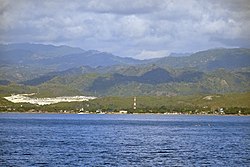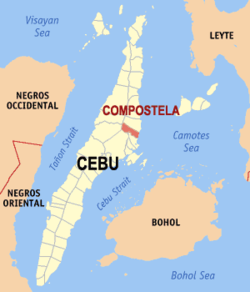Compostela, Cebu
Compostela | |
|---|---|
| Municipality of Compostela | |
 Compostela skyline | |
 Map of Cebu with Compostela highlighted | |
Location within the Philippines | |
| Coordinates: 10°28′N 123°58′E / 10.47°N 123.97°E | |
| Country | |
| Region | Central Visayas |
| Province | Cebu |
| District | 5th district of Cebu |
| Founded Chartered | 26 December 1878 17 January 1919 |
| Barangays | 17 (see Barangays) |
| Government | |
| • Type | Sangguniang Bayan |
| • Mayor | Froilan Quiño |
| • Vice Mayor | Josephine T. Abing |
| • Representative | Vincent Franco D. Frasco |
| • Electorate | 36,622 voters (2022) |
| Area | |
| • Total | 53.90 km2 (20.81 sq mi) |
| Elevation | 35 m (115 ft) |
| Population (2020 census)[3] | |
| • Total | 55,874 |
| • Density | 1,000/km2 (2,700/sq mi) |
| • Households | 13,612 |
| Economy | |
| • Income class | 3rd municipal income class |
| • Poverty incidence | 19.57% (2015)[4] |
| • Revenue | ₱ 173.5 million (2020) |
| • Assets | ₱ 459.2 million (2020) |
| • Liabilities | ₱ 82.66 million (2020) |
| • Expenditure | ₱ 194.1 million (2020) |
| Time zone | UTC+8 (PST) |
| ZIP code | 6003 |
| PSGC | |
| IDD : area code | +63 (0)32 |
| Native languages | Cebuano Tagalog |
Compostela, officially the Municipality of Compostela (Cebuano: Lungsod sa Compostela; Tagalog: Bayan ng Compostela), is a 3rd class municipality in the province of Cebu, Philippines. According to the 2020 census, it has a population of 55,874 people.[3]
Compostela is within the Metro Cebu area.
History
In the year 1844, Spanish authorities established local government units on the northern part of Cebu starting from what is now known as the town of Compostela as far north as what is now called the town of Borbon. Compostela was among the early barrios of the Danao. The newly established barrio was named Compostela on the suggestion of a Roman Catholic friar who came from the town of Santiago de Compostela in Spain and brought along with him the image of that town's patron saint, St. James the Great. Adopting the said saint as the local patron, a parish chapel was built from light materials. As the population grew, the Spanish church authorities decided to elevate the chapel into a church so that in the year 1866 the catholic church was constructed on the same site. Up to present time, the same structure continues to be the major place of worship in Compostela.
At the turn of the 20th century, the Americans gained control over the Philippines when they defeated the Spaniards in the Battle of Manila Bay. As a consequence, the Treaty of Paris caused the reorganization and reclassification of all local government units in the country according to their population and income. The reorganization which took place in 1903 resulted in the secession of Compostela to Liloan. In 1919, Compostela became a municipality.
Geography
Compostela is bordered on the north by the city of Danao, to the west by Cebu City, on the east by the Camotes Sea, and on the south by the town of Liloan.
Barangays
Compostela comprises 17 barangays:
| PSGC | Barangay | Population | ±% p.a. | |||
|---|---|---|---|---|---|---|
| 2020[3] | 2010[5] | |||||
| 072218001 | Bagalnga | 4.1% | 2,283 | 1,922 | 1.74% | |
| 072218002 | Basak | 3.2% | 1,773 | 1,695 | 0.45% | |
| 072218003 | Buluang | 2.4% | 1,365 | 1,259 | 0.81% | |
| 072218004 | Cabadiangan | 4.1% | 2,284 | 2,111 | 0.79% | |
| 072218005 | Cambayog | 2.3% | 1,283 | 1,165 | 0.97% | |
| 072218006 | Canamucan | 7.8% | 4,345 | 4,058 | 0.69% | |
| 072218007 | Cogon | 13.2% | 7,357 | 5,517 | 2.92% | |
| 072218008 | Dapdap | 2.2% | 1,212 | 1,151 | 0.52% | |
| 072218009 | Estaca | 11.3% | 6,327 | 5,177 | 2.03% | |
| 072218010 | Lupa | 1.6% | 873 | 812 | 0.73% | |
| 072218011 | Magay | 4.3% | 2,391 | 2,539 | −0.60% | |
| 072218012 | Mulao | 2.9% | 1,600 | 1,538 | 0.40% | |
| 072218013 | Panangban | 2.0% | 1,104 | 1,125 | −0.19% | |
| 072218014 | Poblacion | 18.6% | 10,372 | 9,536 | 0.84% | |
| 072218015 | Tag‑ube | 2.2% | 1,250 | 1,203 | 0.38% | |
| 072218016 | Tamiao | 2.7% | 1,533 | 1,225 | 2.27% | |
| 072218017 | Tubigan | 1.0% | 546 | 541 | 0.09% | |
| Total | 55,874 | 42,574 | 2.76% | |||
Climate
| Climate data for Compostela, Cebu | |||||||||||||
|---|---|---|---|---|---|---|---|---|---|---|---|---|---|
| Month | Jan | Feb | Mar | Apr | May | Jun | Jul | Aug | Sep | Oct | Nov | Dec | Year |
| Mean daily maximum °C (°F) | 28 (82) |
28 (82) |
29 (84) |
31 (88) |
31 (88) |
30 (86) |
29 (84) |
30 (86) |
29 (84) |
29 (84) |
29 (84) |
28 (82) |
29 (85) |
| Mean daily minimum °C (°F) | 22 (72) |
22 (72) |
23 (73) |
23 (73) |
25 (77) |
25 (77) |
24 (75) |
24 (75) |
24 (75) |
24 (75) |
23 (73) |
23 (73) |
24 (74) |
| Average precipitation mm (inches) | 70 (2.8) |
49 (1.9) |
62 (2.4) |
78 (3.1) |
138 (5.4) |
201 (7.9) |
192 (7.6) |
185 (7.3) |
192 (7.6) |
205 (8.1) |
156 (6.1) |
111 (4.4) |
1,639 (64.6) |
| Average rainy days | 13.4 | 10.6 | 13.1 | 14.5 | 24.2 | 27.9 | 28.4 | 27.7 | 27.1 | 27.4 | 22.5 | 15.9 | 252.7 |
| Source: Meteoblue (modeled/calculated data, not measured locally) [6] | |||||||||||||
Demographics
|
| |||||||||||||||||||||||||||||||||||||||||||||
| Source: Philippine Statistics Authority[7][5][8] | ||||||||||||||||||||||||||||||||||||||||||||||
References
- ^ Municipality of Compostela | (DILG)
- ^ "Province: Cebu". PSGC Interactive. Quezon City, Philippines: Philippine Statistics Authority. Retrieved 12 November 2016.
- ^ a b c Census of Population (2020). "Region VII (Central Visayas)". Total Population by Province, City, Municipality and Barangay. Philippine Statistics Authority. Retrieved 8 July 2021.
- ^ "PSA releases the 2015 Municipal and City Level Poverty Estimates". Quezon City, Philippines. Retrieved 12 October 2019.
- ^ a b Census of Population and Housing (2010). "Region VII (Central Visayas)" (PDF). Total Population by Province, City, Municipality and Barangay. National Statistics Office. Retrieved 29 June 2016.
- ^ "Compostela: Average Temperatures and Rainfall". Meteoblue. Retrieved 10 May 2020.
- ^ Census of Population (2015). "Region VII (Central Visayas)". Total Population by Province, City, Municipality and Barangay. Philippine Statistics Authority. Retrieved 20 June 2016.
- ^ Censuses of Population (1903–2007). "Region VII (Central Visayas)". Table 1. Population Enumerated in Various Censuses by Province/Highly Urbanized City: 1903 to 2007. National Statistics Office.
{{cite encyclopedia}}: CS1 maint: numeric names: authors list (link)
- Wagas, Neil Edwin R (2014). "History of Compostela (Cebu, Philippines)". Archived from the original on 22 August 2016.
{{cite web}}: Invalid|ref=harv(help)


